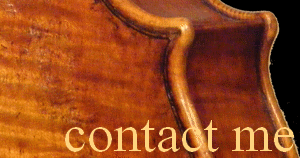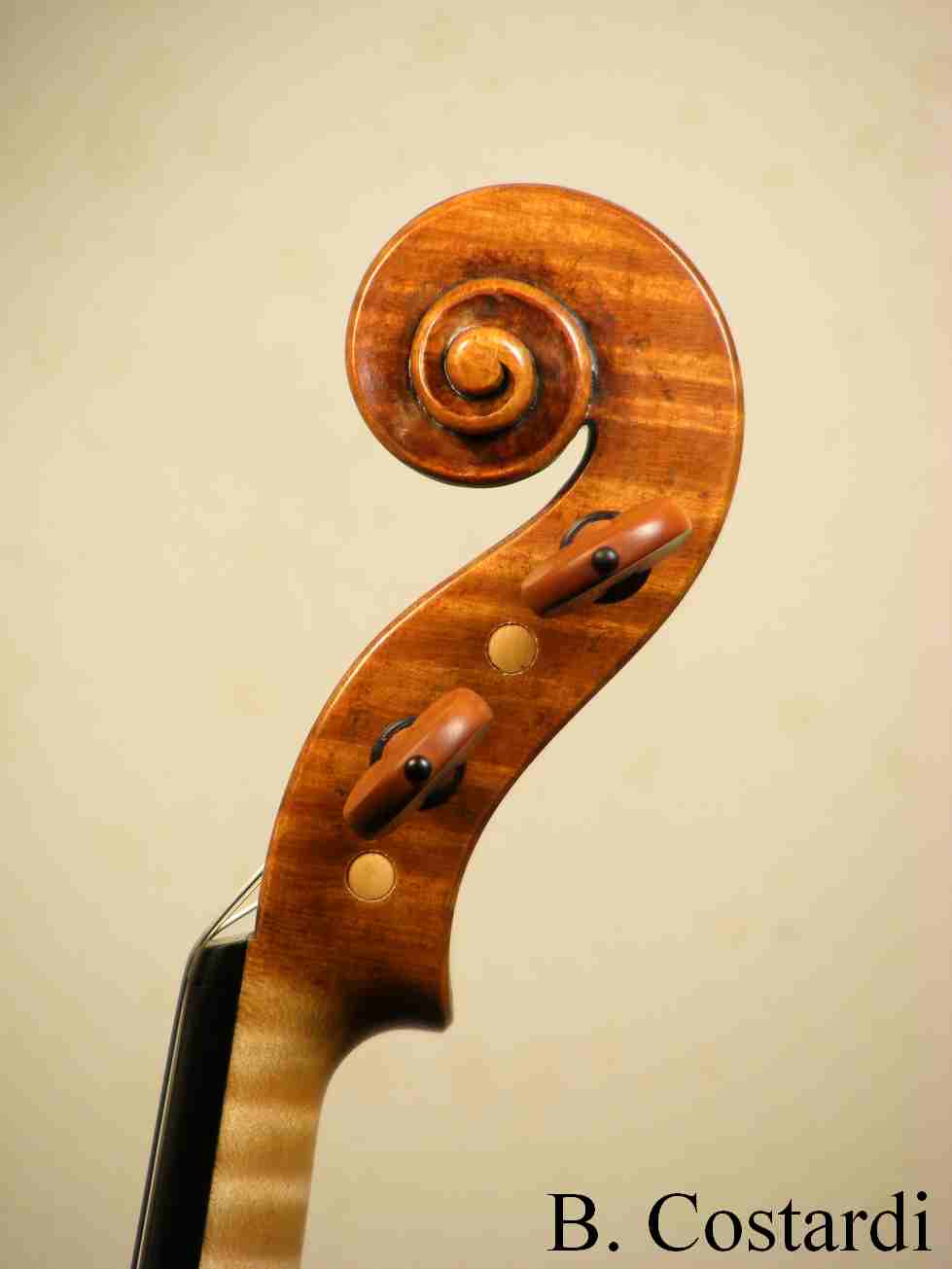 
|
|
Glossary- The parts of a bowed instrument -- BASE PLATE or BACK - The lower lid of the body; normally in maple but can also be in other semi-hard woods (generally the same wood is used for the back , ribs and neck ). The arching is obtained by gouging and sculpting the wood, and thickness is generally greater in the centre, thinning towards the edge areas. - BASS BAR- A bar in spruce, glued lengthways to the inside of the upper plate under the right of the bridge. It's static function is to support the plate, and it is extremely important for the performance of the instrument. Over time it loses tension or nerve, the instrument no longer responds to lower notes and the plate tends to drop and become deformed. The bass bar is one of the parts which should be periodically replaced. - BLOCKS - Six "reinforcements", for the parts which are subject to major tension or blows. They are small blocks of soft wood (fir, poplar, willow or lime) of which four inside the points, one called the "head" because it carries the joint of the neck at the top of the body, and one at the base in the centre, which holds the button and therefore the tension of the strings. In the classic method, construction of the instrument begin with the gluing and shaping of the six blocks. - BOTTON - Tee-shaped peg (made of the same wood as the tuning pegs ) inserted in the lower rib corresponding with the base block. - BRIDGE - In maple, less frequently in plane-tree, it is not varnished, and is held in position by the pressure of the strings. There are various models, characterized by different designs and perforations. Normally the French model is used. - BUTTON - Formed in the base, it has a half-moon shape and is placed above the heel of the neck. - FINGER BOARD - Today, in ebony. Historically in softer wood ("spruce") veneered in ebony or other hard wood; it was shorter and of a markedly wedged shape, given that the neck was almost completely without inclination. - GRAIN - Due to the very different growth of individual trees; light and open in hot seasons, compact and darker in cold seasons. It is made more evident by a quarter cut of the tree trunk, Only slightly visible in maple, it is very evident in spruce. - MENSUR - The length between the upper edge of the body, and the line which passes through the two internal notches of the sound holes : it corresponds approximately to 3/5 of the vibrating strings. In today's violins it is practically standard (195 mm). - MOULD - Normally in plywood to avoid distortion. In traditional construction the mould was used internally and dictated only the internal form. In the French system of the eighteen hundreds, the mould was external, and like a template or stencil defines the instrument's external form. - MOUNTING - In modern mounting, the finger board is in ebony, while in antique times it was in soft wood veneered in ebony or other hard wood. Tuning pegs and the tail piece are in boxwood in the Italian tradition, but more frequently in ebony or palisander. Today natural boxwood is difficult to find and is very expensive, thus one finds mountings on the market in similar woods which are still elegant and reasonably priced. - NECK -Normally an integral part with the "scroll", usually of the same wood as the base plate and ribs. In antique times it was shorter, therefore in antique instruments it has been substituted, rejoining the original head. - PURFLING - Inserted as an inlay near the edge of the instrument, it is generally composed of three very fine strips of wood: two dark and one light. Its function is decorative but contributes also to bind the fibers of the plates especially as spruce tends to wear or chip. (In certain instruments purfling is only traced on the surface.) - RIB LININGS - Strips of soft wood, often spruce, which reinforce the ribs, and increase the surface for gluing to the upper and lower plates. - RIBS - These constitute the contoured shape of the instrument, thin strips, generally of the same wood as the lower plate, composed of six strips , bent with heat. - SCROLL - The most decorative part of the instrument; in antique times it was often enriched with inlays and decorations forming the scroll in the form of a human or animal head. It is one of the details which denotes the personality of the instrument maker. Generally it is an integral part of the neck, and in the same wood as the base plate and the ribs (maple). - SOUND HOLES - Two openings are cut into the harmonic plate. The "written f" shape, the position and the dimension, delimit the central section of the plate, and indicate with their internal notches the central line of the bridge. - SOUND POST - A cylindrical piece of spruce, held in place by the innate tension of the instrument ,between the front and back plates, corresponding with the foot of the bridge on the treble side. Its main static function is to reinforce the belly, to phase the upper and lower plates, and functions as a register to regulate the emission and balance of the sound. - TAILPIECE - In hard wood (ebony, East London boxwood, palisander); normally the same as the tuning pegs. It is attached to the button by a nylon or gut string. It some cases it carries one or more small devices for fine tuning. - TUNING PEGS - These are the "four" pegs in hardwood, (ebony, boxwood or palisander), usually the same wood as the tail piece. The point is cone-shaped and fits perfectly into the hole, allowing the tightening and tuning of the string. - UPPER NUT - An ebony or bone bar placed crosswise found at the end of the finger board, slightly raised above it. It has small grooves to maintain the position of the strings. - UPPER PLATE - This is the upper lid of the body, normally in red spruce and always of a quarter cut. Arching and thickness are obtained by gouging and sculpturing the wood. Traditionally the thickness tended to be uniform. It is internally reinforced by the bass bar which is glued with spring or tension. -WOOD - Today the most frequently used woods employed for the construction of bowed string instruments are:
In antique instruments it is not unusual to find the base plate made from other types of wood instead of maple; base and ribs made in "beech" (Fagus silvatica, Dicotyledon), in poplar, willow, "cherry" (Prunus avium, Dicotyledon) and other woods of similar density, while the harmonic plate is in spruce or other similar conifer. Old Masters often used "poor materials" (even Stradivarius made several instruments in poplar or willow); in the 1600s these materials were however much more costly than today. Think about a trunk of Balkan Maple, carried down the valley by who knows what means, loaded onto a small boat, unloaded in a port, then sawed and seasoned. A voyage using the means of transport available in those times, must have been adventurous and very expensive. The expertise of a master lay in his knowledge of how to thriftily use the materials available ,to interpret it and sometimes to transform a natural defect into an aesthetic detail. |

Use of this Web site means that you
accept the Terms of use
www.minugia.it/glossa-e.htm © 1998 - 2020 Copyright Bruno Costardi
© 1998 - 2020 Copyright Bruno Costardi
www.minugia.it/glossa-e.htm